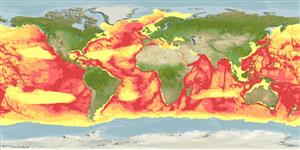Common names from other countries
Environment: milieu / climate zone / depth range / distribution range
Ecologie
Benthopelagisch; diepteverspreiding 0 - 6787 m (Ref. 96968). Subtropical
Circumglobal in tropical and subtropical waters.
Length at first maturity / Size / Gewicht / Leeftijd
Maturity: Lm ? range ? - ? cm Max length : 10.0 cm ML mannelijk/geslacht niet bekend; (Ref. 96968); 69 cm ML (female)
Occurs in mesopelagic and bathypelagic in open waters but often associated with continental slopes (Ref. 114825). Depth range in open-ocean from surface to at least 1,260 m, over depths of up to 6,787 m. Collected in bottom trawls on continental shelves and slopes at depths of 100 to 3,173 m. Possibly not entirely pelagic, but might pass relatively short periods of its life cycle in open waters, soon returning to a life at the bottom especially on continental slopes. Females brood their eggs attached to the oral side of the arm bases near the mouth. Likely an intermittent spawner. The deep umbrella formed by the arms and webs of the female possibly serves as the main organ of locomotion/swimming. When mature, and before autotomized, the hectocotylus of males protrudes from the pouch opening on the inner surface of web between the second and fourth pairs of arms. Feeds on crustaceans and cephalopods (Ref. 96968).
Life cycle and mating behavior
Geslachtsrijpheid | Voortplanting | Kuitschieten | Eieren | Fecundity | Larven
Members of the class Cephalopoda are gonochoric. Male and female adults usually die shortly after spawning and brooding, respectively. Mating behavior: Males perform various displays to attract potential females for copulation. During copulation, male grasp the female and inserts the hectocotylus into the female's mantle cavity where fertilization usually occurs. Life cycle: Embryos hatch into planktonic stage and live for some time before they grow larger and take up a benthic existence as adults.
O'Shea, S. 2004. (Ref. 77104)
Status op de Rode Lijst van het IUCN (Ref. 130435)
Status bij CITES (Ref. 108899)
Not Evaluated
Not Evaluated
Gebruik door de mens
| FishSource |
Tools
Meer informatie
Leeftijd/GrootteGroeiLengte-gewicht parametersLengte-lengte parametersMorfologieLarvenAbundantie
Internet-bronnen
Estimates based on models
Preferred temperature
(Ref.
115969): 1.9 - 5.2, mean 2.9 (based on 7163 cells).
Prijsklasse
Unknown.
